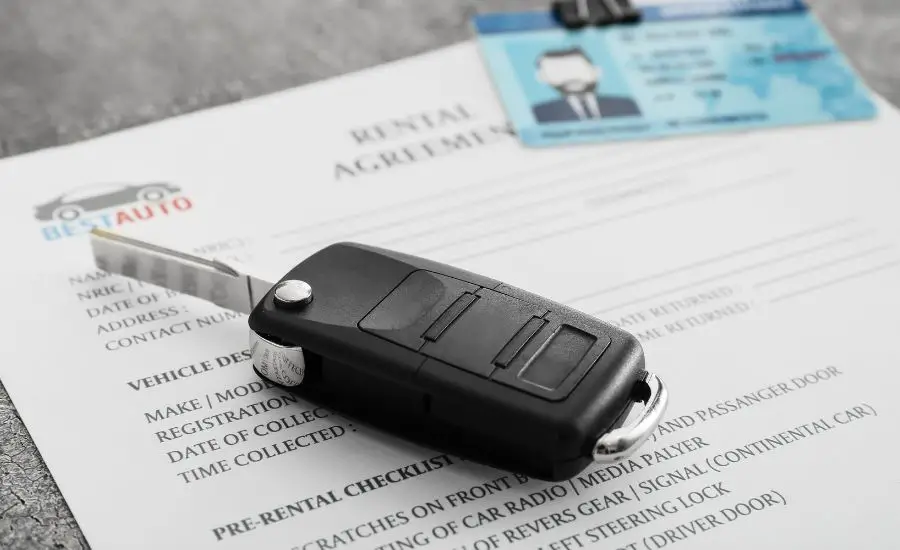Welcome to our blog, where we reveal the actual cost of a scratched rental car.
Many travelers underestimate the financial implications of returning a rental car with scratches and dents.
In this article, we explore the often-overlooked expenses associated with these disadvantages.
Discover why car rental companies charge for damages and learn how these costs can impact your wallet.
Whether you’ve experienced this predicament before or want to be prepared for future mishaps, our insights will help you navigate scratched rental car costs for stress-free travel experiences.

Why do rental car companies charge for damages?
Rental companies have a valid reason for charging customers for damages to their vehicles. Holding customers accountable ensures that their fleet remains in good condition for future renters.
These charges cover the costs of repairing the vehicle and compensate for the loss in value caused by the damage.
Types of damages that incur costs
Not all scratches and dents are equal when it comes to rental car expenses.
Understanding the types of damages that can incur costs is crucial.
Common types include scratches, dents, chipped paint, bumper damage, windshield cracks, and interior stains.

Factors influencing the extent of repair expenses
Several factors come into play when determining the extent of repair expenses for a scratched rental car. These factors include:
Size and severity. Larger or deeper scratches and dents often require more extensive repairs and incur higher costs.
Location of damage. The position of the damage on the vehicle can impact the complexity and cost of repairs.
Type of vehicle. The make and model of the rental car can affect repair costs, with luxury or specialty vehicles often having higher repair expenses.
Car rental company policies. Each rental company has its policies regarding damages and repair charges, which can influence the final cost.
Labor and material costs. Repair expenses can vary depending on the prevailing rates for labor and materials in the rental car’s location.

The financial impact of scratched rental cars
A scratched rental car can have a significant financial impact, and it’s crucial to be aware of the potential costs involved.
Potential costs involved
Repair cost for minor scratches can range from a few hundred dollars to over a thousand, depending on the size and severity of the damage.
More extensive damages, such as dents or bumper damage, can result in even higher repair bills.
It’s essential to consider these potential costs when budgeting for your trip and making car rentals.
Additionally, any damage in the rental car caused by someone else will be treated the same as the ones caused by the owner if the other driver at fault is not identified or if they don’t accept the blame for the incident.
Examples and case studies illustrating real-life expenses
To grasp the real-life financial implications of the scratched rental vehicle, let’s take a look at some examples and case studies:
Sarah’s experience. Sarah rented a compact car for a week-long vacation.
While navigating a narrow parking garage, she accidentally scraped the side of the vehicle against a concrete pillar.
Upon returning the car, the car rental company charged her $600 for the minor scratches repair and an additional administrative fee.
John’s experience. John rented an SUV for a family road trip. During an off-road excursion, the vehicle’s undercarriage sustained significant damage from rocks and uneven terrain.
The repair costs for the SUV amounted to $1,500, leaving John with an unexpected financial burden.

Hidden fees to be aware of
Loss of use fee. Rental companies may charge a “loss of use” fee, compensating them for the revenue they lose while the vehicle is being repaired and unavailable for rental.
Diminished value. Some rental companies may apply a diminished value charge, accounting for the reduced resale value of the vehicle due to the recorded damage.
Administrative fees. Rental companies may impose administrative costs for handling the paperwork and processing the repair charges.
Minimizing the financial burden
When it comes to scratched rental cars, there are steps you can take to minimize the financial burden and protect your wallet.
By following these tips and best practices, you can navigate the rental experience more smoothly and reduce the likelihood of incurring costly damages.
Pre-rental inspection tips and checklist
Before renting a car, conducting a thorough pre-rental inspection is crucial. Follow these tips to ensure you document the vehicle’s condition accurately.
Take your time. Allocate sufficient time to inspect the car thoroughly, both inside and outside.
Use natural lighting. Inspect daylight or well-lit areas to easily identify any scratches, dents, or other damages.
Note every detail. Take pictures or videos of the car’s exterior and interior, paying close attention to existing damages.
Communicate with the rental car company. Bring any pre-existing damages to the attention of the rental car company and ensure they are properly documented in the rental agreement.

Optional insurance coverage and its pros and cons
Most rental companies typically offer optional insurance for damages. Consider the following pros and cons before deciding whether to opt for additional coverage.
Pros of optional insurance:
- Peace of mind. Optional insurance can provide peace of mind by covering potential damages, reducing your financial liability.
- Simplified claims process. If damages occur, filing a claim through the rental company’s insurance can be more straightforward than involving your auto insurance.
Cons of optional insurance:
- Additional cost. Optional car rental insurance comes at an extra expense, which can increase the overall rental cost.
- Overlapping coverage. Your existing personal auto insurance such as collision damage waiver or credit card coverage may already provide adequate protection for the rental car.
However, your insurance may or may not cover the cost of damages, so it’s better to contact your insurance provider before renting a car.
Evaluate your circumstances, including your existing insurance, before deciding on optional rental car insurance from the insurance company.
Determine if the additional cost justifies the added protection.
For example, if you have a collision damage waiver (CDW), the damage waiver will usually cover any losses from theft or rental car damage.
However, the collision damage waiver is highly unlikely to cover any bodily damage to a rental car by an accident.
A collision damage waiver (CDW) can cost you anywhere between $200 and $500 in total, but you will only be liable to pay 20% of the damage costs if there are any, but charges may depend on the rental company’s policies up to $3000.
If you do not purchase the collision damage waiver (CDW), you will have to pay 100% of any rental car damage costs.
So, in addition to that we recommend you to get acquainted with the rental company’s policies before doing any car rentals.
Best practices for avoiding damages during your rental period
Preventing damages during your rental period is the most effective way to minimize the financial burden. Implement these best practices:
Drive responsibly. Adhere to traffic laws, avoid aggressive driving, and be mindful of the vehicle’s size and dimensions.
Park safely. Choose parking spots carefully, avoiding tight spaces or areas prone to door dings.
Avoid hazardous conditions. Be cautious in adverse weather conditions, off-road terrains, or areas with high risk of damage.
Secure belongings. Keep personal belongings properly stored to prevent them from causing damage inside the vehicle.

Returning a rental car with scratches can be daunting, but with the right approach, you can effectively manage the situation and handle potential repair costs.
Here are essential tips for navigating the rental vehicle return process.
Documentation and communication with the car rental company
Take final photos or videos. Before returning the vehicle, document its condition with detailed photos or videos. This provides evidence of the car’s condition at the time of return.
Notify car rental companies. Inform the rental company about any damages you notice during the return process. Discuss the damages openly and ensure they are properly documented.
Review the rental agreement. Familiarize yourself with the terms and conditions stated in the rental agreement regarding damages, repairs, and charges. This will help you understand your rights and obligations.
Open and clear communication with the car rental agent is crucial for transparency and avoiding any disputes regarding damages.

Evaluating repair estimates and negotiating costs
Get repair estimates. If the rental company charges you for damages, request detailed repair estimates from reputable repair shops. Compare them with the charges imposed by the rental company.
Assess reasonableness. Evaluate the reasonableness of the repair costs based on the extent of the damage and prevailing market rates for repairs.
Negotiate if appropriate. If you believe the charges are excessive or unjustified, respectfully negotiate with the rental company.
Provide evidence, such as repair estimates or photographs, to support your case.
Remember to maintain a polite and professional demeanor during negotiations, aiming for a fair resolution.
Understanding the role of your personal auto insurance
- Review your insurance policy coverage. Understand the coverage provided by your personal auto insurance policy for rental cars. Check for cover about damages and liability.
- Contact your insurance provider. In case of damages, contact your insurance provider to determine the extent of coverage and any specific procedures to follow.
- Coordinate with the rental company. Inform the rental agency about your rental car insurance coverage and follow their instructions for reporting and handling the damages.

Conclusion
Managing scratched rental car costs requires awareness and proactive measures.
and proactive measures.
You can minimize financial burdens and car damage by conducting inspections before renting a car, considering optional coverage, and practicing responsible driving to not cause damage to a rental car.
FAQs
1. What should I do if I scratched my rental car?
If you scratch your rental car, document the damage and notify the rental company immediately.
2. Do rental car companies care about scratches?
Rental companies do care about scratches as they affect the vehicle’s condition and value.
3. What does it cost to buff out scratches on a car?
The cost to buff out scratches on a car varies based on factors like depth and length. It can range from a few hundred to a few thousand dollars.
4. Do enterprise charge for scuffed alloys?
Enterprise and other rental companies may charge for scuffed alloys or other damages to the wheels. Review the rental agreement and inquire about specific charges related to scuffed alloys.


